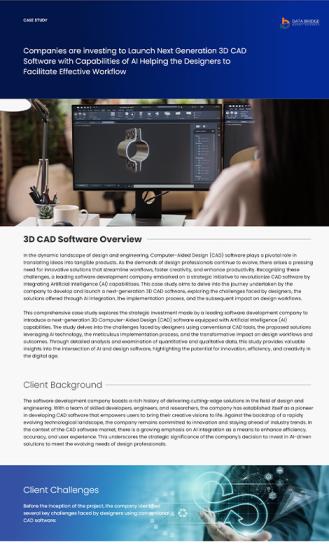3D CAD Software Overview
In the dynamic landscape of design and engineering, Computer-Aided Design (CAD) software plays a pivotal role in translating ideas into tangible products. As the demands of design professionals continue to evolve, there arises a pressing need for innovative solutions that streamline workflows, foster creativity, and enhance productivity. Recognizing these challenges, a leading software development company embarked on a strategic initiative to revolutionize CAD software by integrating Artificial Intelligence (AI) capabilitises. This case study aims to delve into the journey undertaken by the company to develop and launch a next-generation 3D CAD software, exploring the challenges faced by designers, the solutions offered through AI integration, the implementation process, and the subsequent impact on design workflows.
This comprehensive case study explores the strategic investment made by a leading software development company to introduce a next-generation 3D Computer-Aided Design (CAD) software equipped with Artificial Intelligence (AI) capabilities. The study delves into the challenges faced by designers using conventional CAD tools, the proposed solutions leveraging AI technology, the meticulous implementation process, and the transformative impact on design workflows and outcomes. Through detailed analysis and examination of quantitative and qualitative data, this study provides valuable insights into the intersection of AI and design software, highlighting the potential for innovation, efficiency, and creativity in the digital age.
Client Background
The software development company boasts a rich history of delivering cutting-edge solutions in the field of design and engineering. With a team of skilled developers, engineers, and researchers, the company has established itself as a pioneer in developing CAD software that empowers users to bring their creative visions to life. Against the backdrop of a rapidly evolving technological landscape, the company remains committed to innovation and staying ahead of industry trends. In the context of the CAD software market, there is a growing emphasis on AI integration as a means to enhance efficiency, accuracy, and user experience. This underscores the strategic significance of the company's decision to invest in AI-driven solutions to meet the evolving needs of design professionals.
Client Challenges
Before the inception of the project, the company identified several key challenges faced by designers using conventional CAD software:
- Time-consuming Processes: Designers often find themselves spending excessive time on repetitive tasks such as dimensioning, drafting, and detailing. These manual processes not only consume valuable time but also detract from the creative aspects of the design process
- Limited Innovation: Conventional CAD software may lack features and tools that stimulate creativity and innovation in design. Designers may feel constrained by the limitations of existing software, inhibiting their ability to explore new ideas and concepts
- Complex Interfaces: The complexity of traditional CAD software interfaces presents a steep learning curve for both novice and experienced designers. Navigating intricate menus and commands can be time-consuming and frustrating, leading to inefficiencies in design workflows
- Lack of Automation: Automation of routine tasks is often limited in traditional CAD software, resulting in inefficiencies and potential errors in designs. Designers are burdened with manual processes that could be streamlined through automation, such as pattern recognition and part assembly
Recognizing the need for external expertise, the client engaged with DBMR, a trusted market research consulting firm specializing in emerging technologies, to address their challenges and drive business growth. Data Bridge role was to conduct a comprehensive analysis of the market landscape, identify relevant trends, and provide actionable insights for the client's business.


